
The ratings tell the story: Miami is still a top-tier CFB brand.
College Football TV ratings matter. A lot. Conference re-alignment is far from over, and the Big Ten and the SEC are not accepting new programs unless the school (i.e. football team) moves the needle on the conference’s TV ratings so that the conference can negotiate more lucrative TV deals. Even setting aside realignment, the ACC in all likelihood will be switching to a disproportionate revenue sharing model that favors the teams earning the highest TV ratings as part of the ACC’s anticipated settlement of the Clemson and Florida State lawsuits.
Determining who is the ‘most watched’ college football team is not a straight-forward endeavor. For starters, some networks do not report their ratings to Nielsen – most notably the SECN (which broadcast Vanderbilt’s upset of Alabama), the ACCN (which showed SMU v. Pittsburgh when both were ranked), and NBC’s streaming service Peacock (which carried Notre Dame v. Louisville as well as Oregon v. Michigan). Additionally, CBS had a dispute with Nielsen mid-season, so we have no ratings for then No. 13 USC beating Wisconsin. So there’s a few asterisks to this exercise based on missing data.
Another caveat is that certain conferences appear on network TV more often than others. Ben Huddleston at Sports Media Watch posted an excellent breakdown of how networks select what games they carry each week. It’s a thorough article and worth a read if you ever wondered why Miami constantly plays at noon and almost exclusively on ABC or ESPN. But for purposes of this article, what matters is knowing that network coverage (ABC, NBC, CBS, and Fox) will on average have much higher viewership than games carried on cable channels (ESPN, FS1, BTN, SECN, ACCN). The exception is CW – nobody watches the CW. But that is why when networks are selecting the TV slots, Disney will put the three games it thinks will draw the most views on ABC, with the ESPN family of networks getting the leftovers. Thus, the top 27 highest rated contests were shown on a network channel, and only 6 of the top 50 games were on ESPN (none were on another cable network). The ACC and the Big XII only get one, maybe two network games a week whereas the Big Ten and the SEC always get two network games sometimes three.
All this is to say, it’s inaccurate and frankly lazy to make any conclusions from a post on X.com of a list of total viewers for the season because it necessarily excludes dozens of games, particularly from the ACC because many ACC games are shown on ACCN and Peacock. To really get a sense as to which teams are the biggest draw, you have to look at more nuanced comparisons between the games. Most importantly, the time and network the game was shown. Who is getting the best Friday night ratings, or Late (10pm ET or later) ratings, or ESPN primetime ratings? Can a team command high ratings even though it’s a weak opponent? Will the team still get high ratings even though they’ve been losing and slid down the polls, or started the season unranked but have risen up the polls?
When you start breaking the TV ratings down by different metrics, there are three inescapable conclusions this season: 1) Miami is the most watched team in the ACC; and 2) with the exception of Colorado, Miami is the most watched team outside the Power 2 SEC and Big Ten; and 3) Miami would be a strong add for either the SEC or Big Ten as one of the top 10 viewership draws this season.
Top 50 Most Watched Games (through Week 11)
Although it excludes several games that likely would had made this list, let’s at least start with the Top 50 most watched games of the 2024 college football season. Here’s the list:
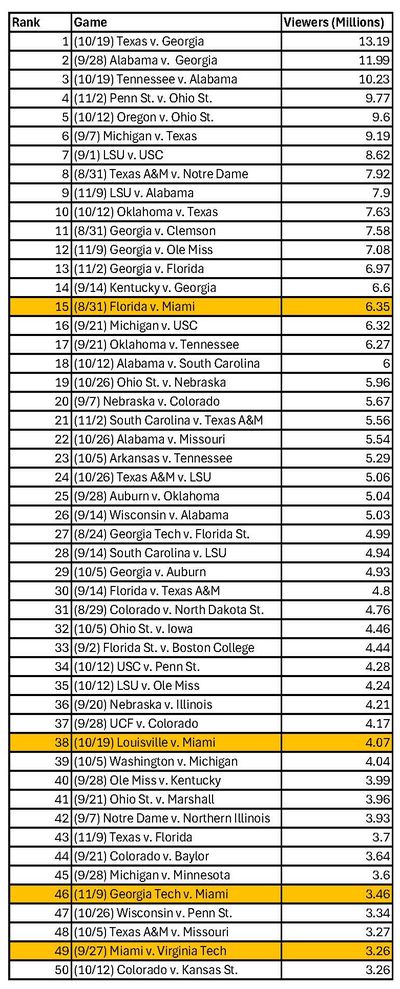
Robert Weaver
As highlighted, Miami appears four times and its opening weekend defeat of Florida is its highest rated game. Here’s a list of teams who have appeared in at least two of these top rated games.
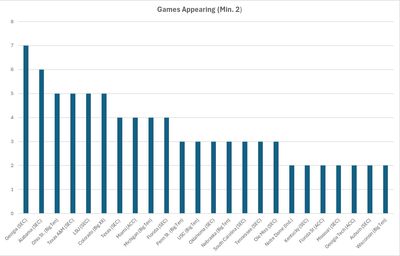
Robert Weaver
Miami is only 1 of 10 teams to have participated in at least 4 of these highest rated games. Florida State appeared twice, but not since the Seminoles lost their preseason top 10 ranking. Georgia Tech appeared twice when they played Miami and Florida State. The other ACC teams to appear were Clemson when they played Georgia, Boston College in Florida State’s other early season contest, and Virginia Tech as well as Louisville when they each played Miami.
Point being is that while high ranked SEC and Big Ten teams play each other and attract big ratings, Miami is over here playing unranked teams and still attracting high viewership numbers . By comparison, consensus number 1 ranked Oregon only appears on this list once when it played Ohio State. As another example, the Florida Gators also appeared in four of these games but only when they’re playing a top ranked team (Texas, Georgia, Miami, and Texas A&M).
Already it should be clear that Miami is easily the most watched ACC team this year, and is at least in the conversation for top 10 most watched teams in the nation, but let’s dig a little deeper.
Friday Night TV Ratings
One of Miami’s most exciting contests this year was its comeback against unranked Virginia Tech on a Friday night. Friday night ratings are interesting at least because Fox made a big gamble to drop WWE Smackdown in favor of college football. So the big Friday night game is usually a Big XII or Big Ten matchup shown on Fox, which as discussed above is usually going to have a leg up on ratings over ESPN and other cable networks. Miami v. Virginia Tech was carried on ESPN, and here’s how that’s compared to other Friday night contests:
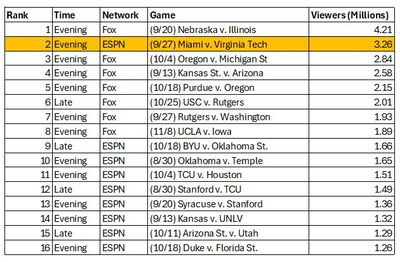
Robert Weaver
One of these things is not like the other…
As explained earlier, the Fox broadcasts are going to generally get higher ratings than ESPN broadcasts thanks to their higher viewership bases. But sitting there at number two is Miami v. Virginia Tech, behind only Nebraska vs. Illinois when both teams were ranked. If the Virginia Tech game was played on Fox or ABC, no doubt it would top this list.
Late Night TV Ratings (10pm ET or later kickoff)
Another point of comparison is Miami’s late night thriller against California. The matchup attracted College Gameday to Berkeley, CA for the first time. How did it fare for TV ratings?
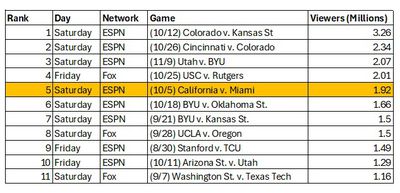
Robert Weaver
So first of all, kudos to Colorado. While Colorado’s viewership ratings have tailed off a bit from last year, Coach Prime and his two Heisman candidates are still one of the most watched teams in the nation.
Setting aside the Buffs, Miami’s late night comeback against Cal was comparable to last weekend’s Holy War as well as a Friday USC game on network Fox that was led in by Game 1 of the World Series (featuring the Los Angeles Dodgers). Not too shabby. Miami even outdrew UCLA v. Oregon, two of the feature teams to join the Big Ten this year.
The Miami v. Cal game was also the highest rated ESPN game that week despite the late kickoff. Miami v. Cal outdrew Clemson v. FSU (1.41M viewers) which aired on primetime and served as the Miami v. Cal lead-in. How amazing is that considering that Clemson and FSU are the ones suing to leave the ACC. LOL!
Also worth noting is not a single ACC team surpassed the 1 million viewership mark for late night games. Cal’s week 3 contest against San Diego St. was the closest with 938k.
ESPN Broadcast Games
Ok, so Miami excelled at ‘weird’ time games better than pretty much everyone not named Colorado. Another great comparison is games on ESPN. Disney has contracts with ACC, SEC, and Big XII – so you won’t see any Big Ten teams on this list unless it was a non-conference game. Also, Disney will put what it believes will be the three most watched games on ABC before filling out the ESPN/ESPN2/ESPNU/SECN/ACCN lineup because, as discussed above, ABC will have a higher base viewership platform than will ESPN.
Still, ESPN aired several interesting matchups this year including SEC contests like Florida v. Tennessee, Ole Miss v. Oklahoma, and Texas A&M v. Arkansas. Miami had five games on ESPN this year: USF (evening slot), FSU (evening slot), Georgia Tech (noon slot), Virginia Tech (Friday evening slot), and Cal (late night slot). Here’s how their ratings compared:
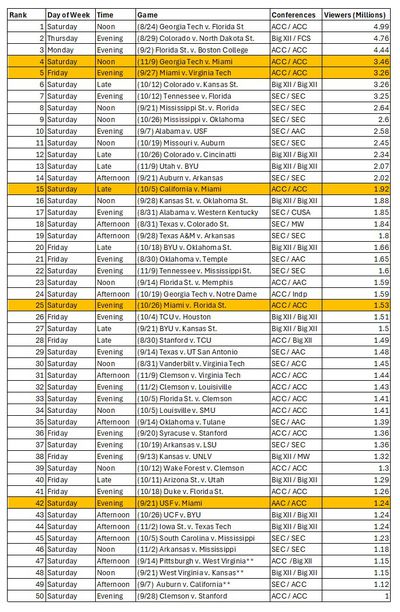
Robert Weaver
Some key observations from this list:
- Every single one of Miami’s games attracted at least a 1.24M viewership number, the lowest being the USF blowout. No other ACC team can boast the same (FSU drew 887K for its Cal game, and Clemson drew 1M for its Stanford game), and very few other teams in the nation can argue that.
- Only six ESPN aired games exceeded 3M viewers and Miami played in two of them. The others were Week 1 upsets, or near upsets, of Florida State and Colorado; Colorado playing a ranked Kansas St. team; and storied rivalry Tennessee versus Florida which was played into OT.
- Miami and Clemson both played Florida State in the ESPN primetime slot, but Miami’s victory outdrew Clemson’s 1.53M to 1.41M.
- Aside from the early season FSU games, no other ACC team is coming close to Miami. Miami’s big games are dwarfing important ACC games like previously ranked Georgia Tech and Notre Dame (1.59M viewers), Clemson v. Louisville (1.43M viewers), and Louisville v. SMU (1.41M viewers).
- In terms of comparing Miami to SEC teams, give credit where credit is due to Alabama. There’s a clear apples-to-apples comparison with Miami as they both played USF in September on ESPN primetime, and Alabama outdrew Miami 2.58M to 1.24M. Aside from Alabama, Miami compares very favorably to every other SEC team that played on ESPN. Miami twice outdrew strong SEC contests like: No. 6 Tennessee needing overtime to beat Florida (3.25M); Oklahoma leading No. 10 Ole Miss at halftime (2.6M); and one loss Missouri erasing an 11 point fourth quarter deficit against Auburn (2.45M).
Network Broadcast Games
Alright, let’s compare Miami to the ‘big boy’ games. Miami appeared on ABC three times this year against Florida in the 3:30pm slot as well as against Louisville and Duke in the noon slot.
The above “Top 50” games already captures most of the network games, so let’s look at these three games from a different perspective: what those games were ranked on each week they were played.
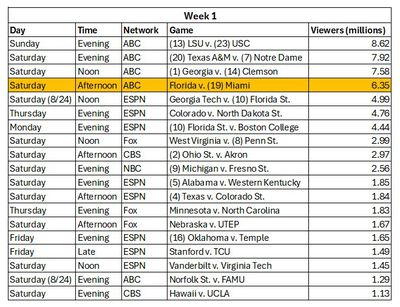
Robert Weaver
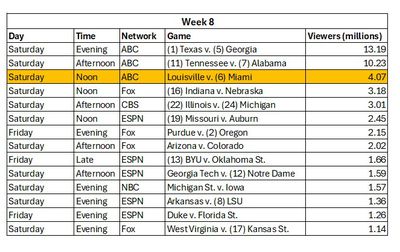
Robert Weaver
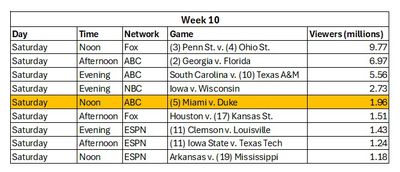
Robert Weaver
Immediate observations for these three games:
- The top drawing games each week involved highly ranked teams facing off with each other (which is why these charts include each teams’ rankings at the time of the game). Miami played unranked teams each time, but still delivered very strong TV ratings especially compared to other ranked teams playing unranked opponents.
- Miami’s Week 1 blowout of Florida in the ABC 3:30pm slot compares well to Georgia’s two touchdown defeat of Florida in the same ABC 3:30pm slot in Week 8. Miami and Florida drew 6.35M while Georgia and Florida drew 6.97M.
- Miami’s Week 8 game against Louisville was a very distant third to the two big SEC games that week, but Miami still attracted more views than Fox’s “Big Noon” game of No. 16 Indiana versus Nebraska as well as the ranked matchups of Michigan v. Illinois aired in the afternoon by CBS (although the monster numbers of Alabama v. Tennessee likely hurt the Michigan v. Illinois ratings).
- Like Michigan v. Illinois in Week 8, Miami’s Week 10 matchup against Duke undoubtedly took a hit being across from the top game of the week of then No. 3 Penn St. v. No. 4 Ohio St. Still, Miami v. Duke outdrew the best that the Big XII could muster as well as Clemson v. Louisville on ESPN in the afternoon timeslot.
Three Key Takeaways
1) Miami is the most watched team in the ACC. This is indisputable. Florida State got an early season ratings boost thanks to: a) playing with an undeserved preseason top 10 ranking; and b) playing its first two matchups with zero games opposite it (Georgia Tech was a Week 0 matchup and Boston College was on a Monday night). Once Florida State’s slide began, the Seminoles viewership ratings plummeted. Also in Week 1, Clemson delivered a monster rating getting blown out by Georgia, but has yet to deliver any ratings remotely close to that even though they kept a respectable ranking in the polls. Clemson’s upset by Louisville in ESPN primetime only drew 1.43M viewers; by contrast California’s near upset of Miami at 2 in the friggin morning drew 1.92M viewers. In comparison after comparison, Miami is clearly the top drawing ACC team this season and it’s not even close.
2) Miami is the most watched team outside the Big Ten and SEC (except Colorado). As discussed above, Colorado gets credit for its high ratings, but would Colorado’s draw continue after Deion Sanders leaves? Highly unlikely. No other Big XII or Group of 5 team merits discussion. And by the way, YES I’m including Notre Dame in this statement. Thanks to Notre Dame’s NBC contract, the Irish find themselves on network TV way more often than Miami, and yet Miami managed to deliver more high viewership games. A good point of comparison was Notre Dame’s comfortable win over Stanford in Week 7. That game was NBC’s afternoon lead-in to Oregon v. Ohio State that evening, but the Notre Dame v. Stanford game only drew 1.87M. That’s less than Miami’s network matchup against Duke (1.96M) and late-night thriller against Cal (1.92M). Notre Dame has to its credit a strong 7.92M rating in its opening week, primetime matchup against Texas A&M which is admittedly better than Miami v. Florida (6.35M) but again, don’t forget that Miami is generating strong ratings despite playing unranked teams. When the comparisons are apples-to-apples, Miami is outperforming Notre Dame this season.
3) Miami Would be a Very Strong Ratings Addition to Either the Big Ten or the SEC
When Miami is at least decent, it is the strongest rating generator that either the Big Ten or the SEC could add in conference realignment. This is not to suggest that Miami is the strongest ratings generator in the whole country – Georgia, Alabama, and Ohio State have staked themselves as the strongest ratings generators this season. The top 5 highest ratings games include at least one of these teams. Any team that plays those three also gets a big rating boost. In the SEC there are other teams like LSU, Texas A&M, Tennessee, and Texas that are also very strong ratings generators that have reasonable arguments for being bigger draws than Miami, but without Miami having yet played a top team it’s tough to say with certainty. Sure each of those SEC teams were part of games that drew higher ratings than Miami, but when you compare apples-to-apples, Miami v. Florida (6.35M) ratings smoked Texas A&M v. Florida (4.8M), Texas v. Florida (3.96M), and Tennessee v. Florida (3.35M). The Big Ten is a little harder to compare with Miami, but nobody other than Ohio State is clearly outdrawing Miami. Oregon might be ranked atop the AP Poll, but aside from their Ohio State matchup their ratings have been fairly unimpressive. In fact, Michigan is probably the second best ratings draw considering it hasn’t been a CFP contender for most of the year and yet still earned solid TV ratings against unranked Washington (4.04M viewers) and Minnesota (3.6M viewers).
Across the entire nation, it’s tough to argue that 9 teams would definitely outdraw Miami for TV ratings in 2024 if the Hurricanes were regularly playing on broadcast TV against ranked teams in the Big Ten or the SEC. If you were to put Miami in the Big Ten or the SEC it would be ratings dynamite. From the perspective of potential to draw viewers, Miami would at least be on par with Oklahoma, USC, and Oregon, all of whom earned invites to the Big 2 beginning this year.
When, not if, there is another round of conference realignment, both the SEC and the Big Ten have to strongly consider luring Miami. The goal of realignment is always to boost the conference’s TV rating value, and Miami has proven that it’s the best option to do so. In the interim, Miami should welcome the push by FSU and Clemson to distribute ACC media rights revenue by viewership ratings.
